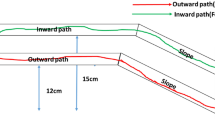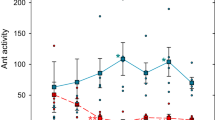Abstract
Forager ants lay attractive trail pheromones to guide nestmates to food1,2, but the effectiveness of foraging networks might be improved if pheromones could also be used to repel foragers from unrewarding routes3,4. Here we present empirical evidence for such a negative trail pheromone, deployed by Pharaoh's ants (Monomorium pharaonis) as a ‘no entry’ signal to mark an unrewarding foraging path. This finding constitutes another example of the sophisticated control mechanisms used in self-organized ant colonies.
Similar content being viewed by others
Main
To investigate whether foragers lay a negative signal on the unrewarding branch of a trail bifurcation, we removed paper substrate from immediately after the fork on the unrewarding branch (the other branch led to a sucrose feeder) after it had been used by a trail-laying colony of ants. This paper substrate was transferred to the entrance of one branch of a similar set-up, in which both branches had previously led to sucrose and had been used by a second colony of ants. The other branch of the second set-up received a neutral control paper substrate (for details, see supplementary information). Foragers walking from the nest could choose either of the test branches or make a U-turn.
We found that 69% continued to walk away from the nest and make a branch choice. Of these, most (71%) chose the branch with the control substrate (χ2=22.1, d.f.=1, n=137, P<0.001); the remainder U-turned towards the nest on reaching the trail bifurcation. U-turns were more than four times as likely if the ant had contacted the unrewarding-branch substrate (55%) as opposed to the neutral-control substrate (13%) (χ2=40.9, d.f.=1, n=200, P<0.0001). Neither substrate came from a previously rewarding trail, so this result cannot be attributed to differences in positive-trail pheromone concentrations.
We next investigated the negative signal's location by taking substrate from five locations on a bifurcating trail that had one rewarding and one unrewarding branch. These sections, along with neutral controls, were tested on unbranched foraging trails (see supplementary information) by noting whether individual foragers walking over them did a U-turn. Compared with ants on the control substrate, almost twice as many ants U-turned when walking on substrate from the unrewarding branch near the bifurcation (Nb) (19% and 34%, respectively; P<0.001) (Fig. 1a). However, U-turns were as frequent on substrate from the unrewarding branch end (Ne) (27%) as on the control (27%) (NS) (Fig. 1a). Ants U-turned less often on sections from the rewarding trail (stem S, 12%; feeder branch close to the bifurcation Fb, 12%; and feeder-branch end Fe, 13%). These values are significantly lower than those for the relevant control (S, P<0.001; Fb, P<0.05; Fe, P<0.001) (Fig. 1a).
The ants' response is monitored by their walking behaviour, with U-turning or zigzagging on unbranched trails indicating detection. Test sections: S, 1 mm before bifurcation; Fb and Nb, 3 mm after bifurcation on feeder and non-feeder branches, respectively; Fe and Ne, 60 mm from bifurcation at the ends of feeder and non-feeder branches, respectively. (For details and chi-squared tests, see supplementary information.) a, Number of ants that U-turned while walking on different test sections, relative to controls. b, Percentage of straight-walking (left bars) or zigzagging (right bars) ants, relative to controls.
In the same experiment, we also determined whether foragers could detect the negative signal before reaching the substrate on which it had been laid, using walking behaviour (zigzagging versus walking straight) as a bioassay. Our results show that significantly more ants zigzagged when approaching substrate from an unrewarding branch just after the bifurcation (P<0.01) or at the branch end (P<0.05) than did controls (Fig. 1b). Conversely, significantly fewer zigzagged when approaching substrate leading to the feeder (S, P<0.01; Fb, P<0.05; Fe, P<0.05) (Fig. 1b).
Our results show that Pharaoh's ants use a sophisticated trail system with a negative, repellent pheromone to mark unrewarding branches. The signal is concentrated at decision points — trail bifurcations5. As it is volatile, it provides advance warning — like human road signs situated before junctions. Across a trail network, the pheromone could help direct foragers to food by closing off unrewarding sections. Exactly how negative pheromones enhance foraging efficiency in trail networks is not known, but they might complement attractive trail pheromones6,7 used by Pharaoh's ants in trail choice, or they could prevent strong positive feedback by attractive pheromones from locking the system into suboptimal solutions1,8.
References
Sumpter, D. J. T. & Beekman, M. Anim. Behav. 66, 273–280 (2003).
Camazine, S. et al. Self-Organization in Biological Systems (Princeton Univ. Press, Princeton and Oxford, 2001).
Stickland, T. R., Britton, N. F. & Franks, N. R. in Information Processing in Social Insects (eds Detrain, C., Deneubourg, J. L. & Pasteels, J. M.) 83–100 (Birkhäuser, Basel, 1999).
Britton, N. F., Stickland, T. R. & Franks, N. R. J. Biol. Syst. 6, 315–336 (1998).
Jackson, D. E., Holcombe, M. & Ratnieks, F. L. W. Nature 432, 907–909 (2004).
Sudd, J. H. Br. J. Anim. Behav. 5, 104–109 (1957).
Jeanson, R., Deneubourg, J. L. & Ratnieks, F. L. W. Physiol. Entomol. 28, 192–198 (2003).
Beckers, R., Deneubourg, J. L., Goss, S. & Pasteels, J. M. Insectes Soc. 37, 258–267 (1990).
Author information
Authors and Affiliations
Corresponding author
Ethics declarations
Competing interests
The authors declare no competing financial interests.
Supplementary information
Supplementary Information
(DOC 217 kb)
Rights and permissions
About this article
Cite this article
Robinson, E., Jackson, D., Holcombe, M. et al. ‘No entry’ signal in ant foraging. Nature 438, 442 (2005). https://doi.org/10.1038/438442a
Published:
Issue Date:
DOI: https://doi.org/10.1038/438442a
This article is cited by
-
Ants evade harmful food by active abandonment
Communications Biology (2024)
-
Emergent communication enhances foraging behavior in evolved swarms controlled by spiking neural networks
Swarm Intelligence (2024)
-
Negative Learning Ant Colony Optimization for MaxSAT
International Journal of Computational Intelligence Systems (2022)
-
Construction of a 3A system from BioBrick parts for expression of recombinant hirudin variants III in Corynebacterium glutamicum
Applied Microbiology and Biotechnology (2020)
-
Sophisticated collective foraging with minimalist agents: a swarm robotics test
Swarm Intelligence (2020)
Comments
By submitting a comment you agree to abide by our Terms and Community Guidelines. If you find something abusive or that does not comply with our terms or guidelines please flag it as inappropriate.




